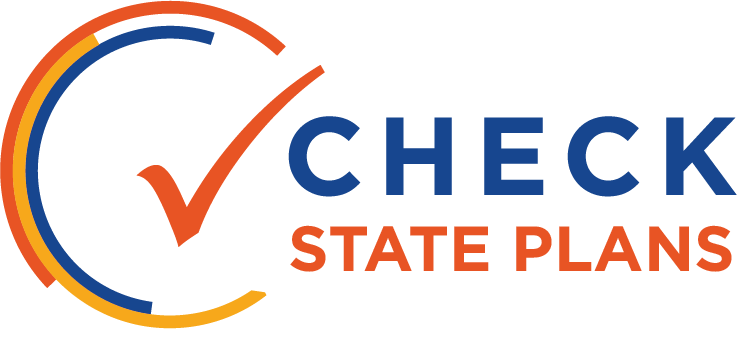Why These Plans Matter
In 2017, 45 experts came together to review every state’s plan for improving their education system. These plans will impact more than 50 million students, more than 3 million teachers, in more than 13,000 school districts across the nation.
That’s why we made sure the peer reviewers were a bipartisan, diverse group with expertise spanning across multiple subject areas.
Pick a category to learn about key components of state plans to improve education – and see how your state measured up.

 GOALS
GOALS
Goals matter – and so does a state’s vision for improving educational outcomes. States need to communicate to parents and policymakers alike that its accountability system is targeted towards achieving its goals, and that its vision, goals, and interim targets are aligned, ambitious, and attainable.
Louisiana
Louisiana’s goals are ambitious, attainable and backed by clear data. The state is proposing to sustain its recent gains and annually increase its proficiency rates. Louisiana has set the same final target for all groups of students but it expects faster progress for groups that are starting further behind. Click here to learn more.
Choose a state to see their plan’s goals:
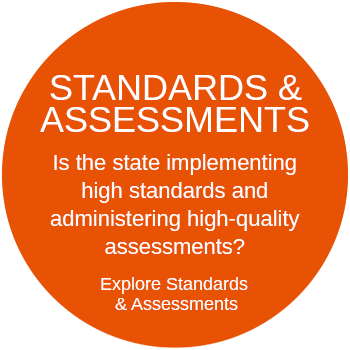
 STANDARDS AND ASSESSMENTS
STANDARDS AND ASSESSMENTS
A commitment to high standards and high-quality assessments aligned to college and career readiness shows a state’s intention to ensure that all students are prepared for their futures beyond high school.
Washington
Washington received top marks for strong commitments to college- and career-ready standards and high-quality, aligned assessments in math and English Language Arts. The state also administers a high-quality alternative assessment to students with the most significant cognitive disabilities and a high-quality English language proficiency assessment for English learners. Click here to learn more.
Choose a state to see their plan for standards and assessments:
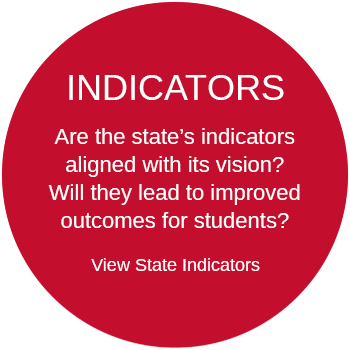
 INDICATORS
INDICATORS
Indicators are only as meaningful as the information they provide. States had an opportunity to choose holistic and meaningful accountability indicators to measure student progress, which should be aligned to ensure that targets and goals are met – and likely to lead to improved educational outcomes for students.
New Mexico
New Mexico proposed a high-quality list of meaningful indicators, including the growth of the lowest-performing students, extended-year graduation rates, chronic absenteeism, and a new college-readiness indicator. Click here to learn more.
Choose a state to see their plan’s indicators:
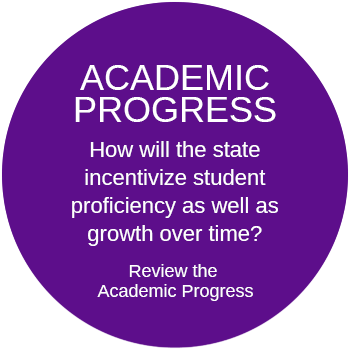
 ACADEMIC PROGRESS
ACADEMIC PROGRESS
States must measure whether or not students are growing over time, and if schools are helping them to do so – without losing sight of the ultimate goal that students are reaching proficiency.
Minnesota
Minnesota’s academic achievement indicator is based on the percentage of students who meet or exceed standards in English language arts and math. For elementary and middle schools, Minnesota will use a growth-to-proficiency model that awards points based on students improving through achievement levels on state math and English language arts assessments. The way that this system awards points is structured such that those students who make the greatest growth earn the most points. Furthermore, the system awards significantly more points to schools that move students from failing to meeting standards Click here to learn more.
Choose a state to see their plan for measuring academic progress:
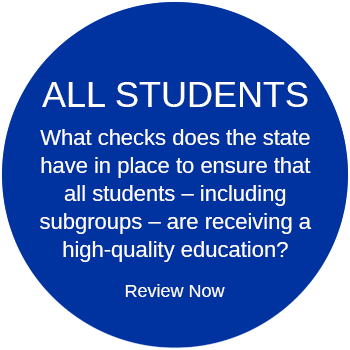
 ALL STUDENTS
ALL STUDENTS
The success of a state’s education system is reflected in the performance of all of its students. States must have checks in place to ensure that all students – including individual groups of students – are receiving a high-quality education.

Unfortunately, no states received top marks from reviewers in this category.
Choose a state to see their plan for all students:

 IDENTIFYING SCHOOLS
IDENTIFYING SCHOOLS
States are required to identify schools and student groups that need additional supports. Each state must include the appropriate mechanisms for identifying those that are most in need of targeted and comprehensive support.
Louisiana
Louisiana’s A-F school rating system provides stakeholders with a single, clear, summative rating to understand school performance and demonstrates how it will identify close to 17% of its schools for comprehensive support and improvement, well above the 5% required under federal law. Click here to learn more.
Choose a state to see their plan for identifying schools:

 SUPPORTING SCHOOLS
SUPPORTING SCHOOLS
Interventions in comprehensive and targeted support schools are necessary to ensure their future success. But are the state’s interventions evidence-based and rigorous enough to match the challenges that these schools face?
Rhode Island
Rhode Island’s plan for supporting schools is exemplary and offers many approaches other states could learn from. It features a state-curated hub of resources, tools, and information for all identified schools, coupled with comprehensive, robust strategies for schools facing the most significant challenges. Click here to learn more.
Choose a state to see their plan for supporting schools:

 EXITING IMPROVEMENT STATUS
EXITING IMPROVEMENT STATUS
Schools that exit improvement status must demonstrate progress – so a state’s criteria for no longer being classified as needing support should ensure sustained improvements.
Indiana
Indiana’s exit criteria are quite rigorous, requiring that comprehensive and targeted support schools reach at least a C grade for the entire school or the low-performing subgroup, respectively, for two consecutive years before they are eligible to exit improvement status. This is likely to represent significant improvement, and maintaining that level for two years should help avoid the risk of backsliding after only one year of improvement. Click here to learn more.
Choose a state to see their plan for exiting improvement status:
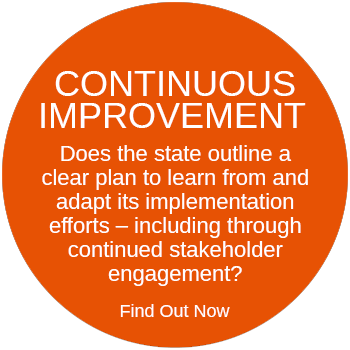
 CONTINUOUS IMPROVEMENT
CONTINUOUS IMPROVEMENT
Improvement doesn’t stop with a new state plan. States must outline a clear path for it to learn from and adapt its implementation efforts. Continued consultation and engagement of key stakeholders will help ensure success.

New Mexico
New Mexico outlines a number of ways it has and will continue to engage stakeholders on key aspects of its implementation efforts. For example, it will be adding science as an indicator in its accountability system in response to stakeholder feedback, and it will continue to gather input as it considers revising their “Opportunity-to-Learn” survey both of which will go into effect in the 2018-19 school year. ” New Mexico’s “Return Tour” across the state will present an overview of the submitted plan, how it changed in response to initial stakeholder feedback, and how the state will implement the plan going forward. Click here to learn more.
Choose a state to see their plan for student progress:
